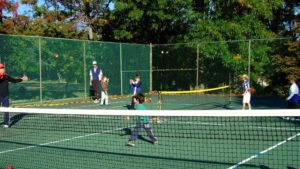On-Court Curriculum
See our On-court Offerings
We teach, train and coach ages 3 to 103.
One curricula – many coaches.
Holistic, Modern, Performant, Social, and Fun!
Topics:
General Information
Scaled for Success
Safety
Social
Groups
Private, Semi-Private, & Family Private
High-Performance Play
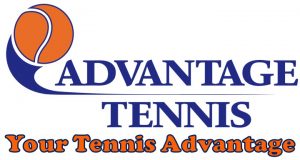
General Description
We are a developmental organization, understanding that skills underpin abilities which enable tactics and strategy.
Continuous Improvement and Continuous Learning are our Way.
Our learning model is probably the most advanced in Virginia.
Safe, social, fun, and improvement is our credo. Play-based is core in our methods. Playing your best, under pressure, is the outcome.
We offer coaching at all recreational levels including preschool kids, and all school age kids through collegiate young adults, seniors, parents, and league and tournament players, at your courts or ours.
We Help Players Develop Faster
See our On-court Offerings
Different class types and on-court venues for Adults and Kids
Adult Programs (expand for more...)-
Adult Programs
-
Cardio Tennis – the Official Cardiovascular Fitness Fun on a Tennis Court – Heart rate targeted, possibly the most fun you’ve ever had.
-
Doubles Tennis – Your Partner and You are More Than a Team
-
Family Education – It takes a village to develop a player
-
Fitness Testing and Training – Get Fit to Play
-
Lessons – Groups we form, Groups you form, Private and Family lessons
-
Mental Emotional Discipline – What good are your strokes if you’re too nervous to use them
-
Practice – Practice makes progress. Whether working on skills or tactical abilities, drills and other types of focused practice drives improvement most quickly.
-
Serve, Rally & Score (SRS) – Etiquette, The Code, Score Keeping and Proficiency
-
Socials, Hit-Arounds, Round-Robins – Play!
-
Teams and Competitive Play – Leagues, Ladders, Mini-Tournaments, and Custom Matches. Test your development; Develop competitive skills.
-
Yoga – Core Fitness, Mindfulness, Breathe that’s Tennis! That’s Yoga!!
-
Kids & Junior Programs (expand for more...)
Junior & Kids Programs
-
-
Tiny Tennis – 3-5 Year Old Players Deserve Their Own Creative Curriculum
-
5 – 18 Year Old Players – Every part of our junior curriculum is age and ability based:
-
commonly with overlapping ages (e.g. 5-7s, 7-9s…) on every 3rd year
-
properly scaled for children at every age
-
age appropriate physical, mental, emotional, and social development
-
Character Curriculum – Competitive Tennis Naturally Trains Character, We Supercharge It Starting at Age 5
-
-
Fun Intensive Tennis Training (FITT) – Half or full days of fun, Holistic Development every day for a Week
-
Lessons – Groups we form, Groups you form, Private and Family lesson
-
Practice and Play – Focused Practice and Appropriate Play. Practice makes Progress; Play is What We All Do
-
Serve, Rally & Score (SRS) – Etiquette, The Code, Score Keeping and Proficiency
-
Teams and Competitive Play – Leagues, Ladders, Mini-Tournaments, and Custom Matches. Test your development; Develop competitive skills.
-
Positively Tennis Academy (formerly Complete Player Program)
-
Player Triangle Required. Includes 3 Curricula in 1
-
Modern Technical, Tactical, and Strategic play
-
Fitness Testing and Training – Get Physically Fit to Play
-
Mental Emotional Discipline – Get Mentally Fit to Play
-
-
Goals, Plans, and Measurement for each player
-
-
School programs – Start the Lifelong Educational Journey Now
Scaled for Success and Faster Improvement:

We use the low pressure (red, orange and green) and traditional standard (yellow) balls in our classes to enhance success, develop certain skills, and/or for equalization between players of different levels and at all ages. And of course we use them to help keep things in proper scale for our small, young players.More...
For all tennis players it has to be fun, and for 3 to 5 year old kids it is especially about instilling a positive association with this wonderful lifelong sport. Fundamental ABCs (agility, balance, coordination) and the good beginnings of hand-eye coordination are the athletic focus of what is a theme based, creativity and imaginary, curriculum for 3 to 5 year olds.
For children, starting with 5 to 7 year old kids, we use the ITF/USTA standardized scaled play models. With the red, orange and green balls we have kid-sized courts of 36′ (Red), 60′ (Orange), and 78′ (Green/Yellow) to help young players develop skills and tactics quicker and earlier without being on courts that are too big, with balls that bounce too high, and racquets that are too long.
Lower nets, smaller courts and especially the low pressure balls allow beginners a faster transition to tennis play and quicker success for all ages. Play-based player development has allowed us to all but eliminate lines in our tennis programs. (Oh, but the kids do love to play “Pool”)
Tennis players can only achieve their best if they are mentally, emotionally, and physically on their game. And positive character traits are needed in sport and life as well. All this is baked in to our holistic approach to kids tennis.
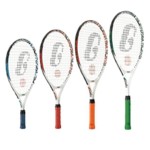
Tennis is a game of controlled power in specific dimensions. Controlling direction, depth, pace and spin has different learning opportunities with properly scaled tennis (balls, racquets & courts).
We can also recommend racquet types, strings and grips for your style of play. It is important that your child have the proper sized racquet; and using the properly bouncing (low compression) ball may be the difference between success and frustration for your young player.
Loaner racquets are available for the first class if needed.
Safety
Before starting any class please notify your coach of any medical conditions that may require attention during physical activity or in the playing environment
Group lesson physical safety is primarily a function of player self awareness and the organization of class activities. More...
Children in our programs are reminded that safety means physically, mentally, and emotionally. Safety is our first Rule, right along with Fun (Rule #2). However it obviously cannot be fun if it is not safe.
When you register for a program you have the opportunity to provide us with emergency contact information. Hopefully we will never ever need it, however we want to have the right contact information should something happen.
Players are responsible for their actions, and coaches are responsible for organizing players and activities to reduce safety risks to acceptable levels.
For environmental safety you can see our weather policy here.
Social
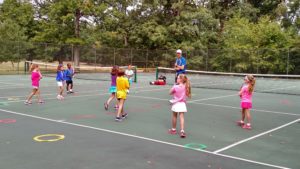
Tennis is naturally social, and the remarkable Danish longevity study had the medical community wondering whether the social nature of tennis was a significant contributor to adding a decade of lifetime. More...
Besides the honorable communications that are needed to execute your tennis match, remember practice makes progress. During your practice and play sessions you have all sorts of opportunity to visit with your friends and/or make new ones.
Before play, after play, during a water break – socialize.
We want to get to know you, not just as a player. Get to know you’re coach. We are here for you.
Tennis socials, round robins, and Hit-arounds are all examples of excuses to socialize and play tennis. Of course we shouldn’t need an excuse to play and socialize.
We encourage social interactions during our programs for all ages. With kids we sometimes have to foster the interaction, and those activities are included in our classes.
Group Classes
Group lessons for teams provide the opportunity for social play environments, and collegial encouragement among players. We coach group lessons at all of our locations.
Each lesson grouping size has its advantages. From the individualized focus of private coaching, to the peer learning and group experience, both can be good ways to learn.
More...With kids, group lessons may help to motivate youngsters to try and do more things. Also, kids teaching kids is a very effective part of a good learning environment.
Kids, particularly younger ones, can generally benefit from larger group (peer) activities including fitness activities and group games when the activities are well focused.


Group lessons are most productive if the students are mostly close in ability and/or skills, as well as considering focus and maturity for kids.
Self-Formed Groups:
You can form your own group to attack a common tactical or technical learning objective, or just to have your friends or family in a group with you.
Some of our curriculum such as, Complete Player Development, Doubles, Fitness Testing and Training, and Mental/Emotional Discipline are commonly taught in self-formed groups.
Group lessons can be of 2 or more players, and we commonly call a 2 player group a semi-private class.
Private, Family Private, and Semi-Private Classes
These lesson types are individually coached, and are typically for 30, 60 or 90 minutes at a time, even though they are mostly priced by the hour.
For these Private, Semi-Private and Family classes there are several key differences when compared to how we administer most of our regular group lessons.More...
You will have a closer and more tailored interaction with your coach, which will include individually personalized activities and drills.
If you are getting a series of lessons and working toward certain goals you may get videos to watch, and in Private lessons you may have video taken as well.
Your children probably will not get the full obstacle course, although they will almost certainly receive movement training of some type. Your children probably will not get the full Character-driven programming that kids groups get.
One similarity with all our lessons is that the first 3 “Rules”, Safety, Fun, and Effort, are always the same.
Another similarity is that private, Semi-Private, and Family private classes can include same types of content of many of the group programs such as, lessons with skill development, ability drills, play for fun, and Advanced Score.
Small Group lesson contents are generally a mix between our regular group classes and the Private/Semi/Family classes. You can see more specifics about the Small Groups just below.
Private Lessons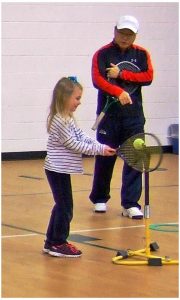
Private lessons means 1 player and 1 coach.
If you are already a player and have a specific skill/ability that you desire to develop or improve, there may be no substitute for a private lesson (and some quality practice ). More...
Even with fun as a focus, private and semi-private lessons require more focus and mental energy than a larger group lesson. For this reason, private lessons need to be considered carefully for children under 8 and those who are not yet “invested” in tennis.
30 minutes of 1-on-1 instruction is about the focus limit for many kids 8 and under, and an hour could be too long. On the other hand, we’ve had many shy young children who feel more comfortable starting off in a private lesson before joining a group.
The vast majority of our private lessons are player development, skill building focused. To get the most development and skills you should plan for a minimum of 2 to 3 hours of practice for every hour of lessons, and targeting 4 or more practice hours for each hour of instruction is even better.
Drills, hitting lots of balls, and focused practice, is the next most popular private lesson type. We don’t generally just provide hitting partners. If you are trying to accelerate your learning, the focus of a private or semi-private lesson may be the edge you need.
Semi-Private Lessons
Semi-private lessons, 2 students from different households and a coach.
Examples of common semi-private lessons are with adult league players; children who are friends; or two players wanting specialized attention.
Sharing a lesson with a friend or teammate can be a great way to get personalized attention and stretch your money.
Doubles players frequently come in small groups of 4, but if you are looking to really improve you fundamental play skills, physical and/or mental/emotional, then a semi-private or private may be what you want.
If you are trying to accelerate your learning, the focus of a private or semi-private lesson may be the edge you need.
Family Lessons

Families of the same household, parents and children, can also frequently have fun learning together. Thus why we offer Family Lessons.
Note: Lessons with a parent and child is considered to be a family lesson, not a semi-private. More...
As with all skill-building lessons, with Family lessons it is usually most productive if all students are at least somewhat close in ability and/or skills. However this is frequently not the case, but don’t worry. Family tennis is quality family time.
Depending on the age(s) of the child(ren) the lessons may lean toward the lowest level ability player, or an average that is not optimized for any specific family member. Sometimes we break the hour family lesson into 2 half hour lessons.
Frequently the family combination ends up focusing more on the child’s needs, but that balance is up to the parent. Your coach will discuss the approach with you.
Family lessons are also frequently made up of sibling children, and are also commonly multi-generational with a parent and child, or parents and children.
However it suits your family we’ll do our best to help everyone have fun and improve. If it is multi-generational you probably will want to discuss family social preferences with your coach before the lesson.
High-Performance Training
We train children in high-performance methods starting with our 5-7s groups – The holistic disciplines are key as they mature into competition-ready players.
Ingredients of high-performance play in the ways we offer them are:
- Movement and Fitness
- Mental – Emotional Discipline
- Modern Strokes
- Character Crafting
- Proper Groupings
- Social Intelligence and Fun
- Parent – Player – Coach Relationships
Teaching efficient game play to developing juniors and novice adults is also important to performance and is taught through our Serve, Rally and Score classes.
Our Positively Tennis Academy includes all this.
To develop as athletes, and the best tennis players they can be, your child needs to grow up playing multiple sports. Each sport improves athleticism for other sports, and some sports art better for tennis cross training than others.
Whether or not your child desires to play collegiate, nationally ranked, or international touring levels, becoming a complete player is becoming a high-performance person in life.
